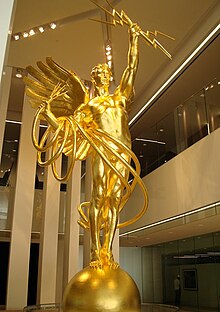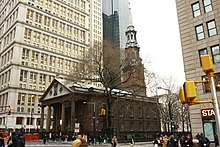195 Broadway
The northwestern corner of the building was designed similar to a campanile with a stepped roof, which formerly supported the Spirit of Communication statue.
The Greek design carried into the large lobby, clad with marble walls and floors, and containing sculptural ornament by Paul Manship and Gaston Lachaise.
[4] Though William Welles Bosworth is credited as the architect, the design of 195 Broadway was largely influenced by AT&T Corp. head Theodore Newton Vail.
"[7] For the lobby, Bosworth was inspired by the design of the Parthenon's porticos and Egyptian hypostyles to create "a forest of polished marble" supported by massive columns.
[19] The lowest story of each layer of Ionic colonnades contained mullions and spandrels made of stone, which contributed to the building's "solidity".
A tall parapet at the building's top was intended to show "strength and solidity binding the columns", as did the structure's transitional bays.
[16] On the Fulton Street side, the westernmost three bays comprise a 422-foot (129 m) tower[21] whose facade consists of an ornate three-story base and a relatively undecorated 22-story granite shaft.
[25] Sculptor Paul Manship designed decorations for the interior, including elevator doors, floor panels, and drinking fountains made of bronze.
[33][34] The oldest section of the building, on the southwest side facing Dey Street included a lobby, shops, offices, fire stairs, and a narrow bank of elevators near the east wall.
[35] The wings contain asymmetrical column arrangements, but this is not immediately visible from the Broadway lobby due to the presence of the elevator banks.
[39] Following a renovation that year, the lobby was slightly reconfigured to include three storefronts separated by full-height glass barriers and connected by a galleria.
The artist Evelyn Beatrice Longman created a statue depicting a 24-foot-tall (7.3 m) winged male figure on top of a globe, wrapped by cables, clutching bolts of electricity in his left hand.
[43][26] After a court-ordered divestiture of Western Union, the statue's official title was changed to Genius of Electricity by the time it was installed.
[26][46][47] The Manship reliefs are located above the revolving doors on the Broadway side,[16] as well as at the spandrels within the four westernmost bays along Dey Street.
[50] The current building at 195 Broadway was constructed under the leadership of AT&T's president Theodore Newton Vail, who had taken the role in 1907 and assumed the same title at Western Union in 1909 when that firm was purchased by AT&T.
[15][57][61] The 195 Broadway Corporation also bought numerous adjacent plots of land to ensure that the new structure would be compliant with the upcoming 1916 Zoning Resolution,[57] which established limits in building massing at certain heights.
[57] An agreement was made with the Interborough Rapid Transit Company (IRT) to construct an entrance and exit from the base of 195 Broadway to the Fulton Street subway station in 1915.
Bosworth filed plans for a smaller addition to complete the corner of Fulton Street and Broadway in December 1919; it was initially denied for violating the zoning law's height restriction, but the following month, the city board of appeals allowed construction to proceed.
[1][15][68] The company also founded radio station WEAF, which broadcast from 195 Broadway's Fulton Street tower and continued to do so after its 1925 purchase by RCA.
[53][69] In 1941, The New York Times reported that work on the then-under-construction radio apparatus at 711 Fifth Avenue, the studios of RCA's NBC division, was controlled from "a single little room" within 195 Broadway.
[72] The next year, AT&T decided to display "the most accurate clock in the world" on the northernmost window bay along the Broadway facade, a showcase of the successful timekeeping service developed by AT&T's Bell Labs.
AT&T planned to replace the bronze grilles and alabaster chandeliers,[76] but this was canceled after objections from architecture writer Henry Hope Reed.
[78] This new AT&T Building was designed by Philip Johnson in the new Postmodern architectural style, and was completed in 1984, the same year of the Bell System divestiture.
[79] As part of the divestiture, 195 Broadway, and the rest of the block where it was located, was sold for $70 million to businessman Peter Kalikow in May 1983, using the profits to found a charity.
[5] Kalikow destroyed two smaller structures near the block's western boundary, and he initially planned to extend 195 Broadway all the way to Church Street as a 29-story office annex.
Kalikow bought air rights from the adjacent St. Paul's Chapel to the north and changed the plans for the western part of the block back to a hotel.
[85] As part of the construction of the nearby Fulton Center transit hub, 195 Broadway was to be connected to the underground Dey Street Passageway.
[40] As of 2024[update], tenants include: In 1914, a writer for The New York Times stated that Bosworth and AT&T officials had collaborated to provide a building that would serve as "an artistic addition to the towering commercial structures of the lower part of the city", with a well-planned interior design.
[17] Kenneth Clark, writing for Architectural Record, stated that the detail paid to the Greek-inspired features was among the building's "strongest points".
[101] By the time Kalikow took ownership of 195 Broadway in 1984, he saw that the cast-bronze interior ornamentation had been painted, and said that "I got the feeling that what [AT&T] were trying to do was play it all down [...] They didn't want anyone to know they lived in a palace.







